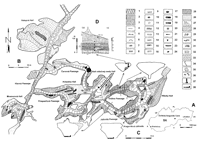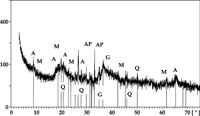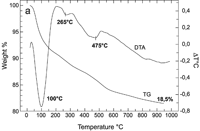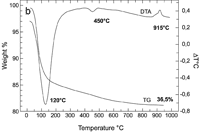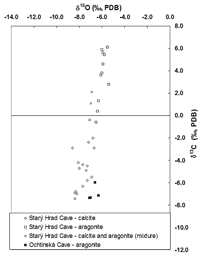Bosák P., Bella P., Cilek V., Ford D. C., Hercman H., Kadlec J., Osborne A. and Pruner P.
Abstract: Ochtiná Aragonite Cave is a 300 m long cryptokarstic cavity with simple linear sections linked to a geometrically irregular spongework labyrinth. The limestones, partly metasomatically altered to ankerite and siderite, occur as lenses in insoluble rocks. Oxygen-enriched meteoric water seeping along the faults caused siderite/ankerite weathering and transformation to ochres that were later removed by mechanical erosion. Corrosion was enhanced by sulphide weathering of gangue minerals and by carbon dioxide released from decomposition of siderite/ankerite. The initial phreatic speleogens, older than 780 ka, were created by dissolution in density-derived convectional cellular circulation conditions of very slow flow. Thermohaline convection cells operating in the flooded cave might also have influenced its morphology. Later vadose corrosional events have altered the original form to a large extent. Water levels have fluctuated many times during its history as the cave filled during wet periods and then slowly drained.
Mn-rich loams with Ni-bearing asbolane and birnessite were formed by microbial precipitation in the ponds remaining after the floods. Allophane was produced in the acidic environment of sulphide weathering. La-Nd-phosphate and REE enriched Mn-oxide precipitated on geochemical barriers in the asbolane layers. Ochres containing about 50 wt.% of water influence the cave microclimate and the precipitation of secondary aragonite. An oldest aragonite generation is preserved as corroded relics in ceiling niches truncated by corrosional bevels. TIMS and alpha counting U series dating has yielded ages of about 500-450 and 138-121 ka, indicating that there have been several episodes of deposition, occurring during Quaternary warm periods (Elsterian 1/2, Eemian). Spiral and acicular forms representing a second generation began to be deposited in Late Glacial (14 ka – Alleröd) times. The youngest aragonite, frostwork, continues to be deposited today. Both of the younger generations have similar isotopic compositions, indicating that they originated in conditions very similar, or identical, to those found at present in the cave.
Keywords: Slovenské rudohorie Mts., Ochtiná Aragonite Cave, cave morphology, speleogenesis, mineralogy, aragonite, U-series dating
Introduction
Ochtiná Aragonite Cave is unique among the 4,250 known caves in Slovakia, although with only 300 m of passages it is relatively small (fig. 1). The cave was discovered in 1954 during the excavation of an adit (Kapusta Gallery) for iron ore exploration. The mine workings also intersected other, smaller caves but none were so interesting or significant. The cave was opened to the public in 1972 and in 1995 was included in the UNESCO World Heritage List as a component of the Caves of the Slovak and Aggtelek Karsts.
fig. 1. Geomorphological map of the Ochtiná Aragonite Cave, showing typical cross-sections (after Bella, 1998, modified) and the sediment section in Oválna Passage with positions of the palaeomagnetic samples (black squares) and the magnetostratigraphic results (black – normal polarised magnetozone, white – reverse polarised magnetozone; for explanations see the text). Corrosion-denudation forms: Planar speleogens: 1 – horizontal solutional ceilings (Laugdecken); 2 – inclined planar walls of passages and halls descending to the floor (planes of repose, Facetten); 3 – inclined, more or less planar walls of passages and halls with smaller corrosion convex and concave forms; Concave speleogens: 4 – shallow oval irregular spoon-like depressions on roofs and walls; 5 – deeper distinct oval irregular depressions on roofs and walls; 6 – distinct, mostly horizontal niches; 7 – cupola-shaped depressions in roofs; 8 – shallow elongated channel-shaped forms in roof; 9 – horizontal elongated notches on walls; 10 – blind lateral tube-like holes; 11 – rocky windows in bedrock; 12 – narrow steep corrosion cavities developed along prominent fissures; 13 – horizontal shallow trough-like depressions; 14 – tubular karren; 15 – fissure karren on collapsed blocks; 16 – shallow drip-holes on collapsed blocks; Convex speleogens: 17 – large irregular bedrock protrusions in roofs; 18 – structurally-controlled large elongated roof bedrock juts on roofs; 19 – less pronounced elongated roof bedrock juts on roofs controlled by bedding; 20 – bedrock pendants; 21 – bedrock blades; 22 – elongate, indistinct and irregular bedrock protrusions along walls; 23 – elongated bedrock protrusions above horizontal corrosion notches; 24 – oval bedrock protrusions in floors; Structural-tectonic forms: 25 – smooth breakdown surfaces without corrosional relief; Depositional forms:26 – sediment sequences; 27 – cones and banks of sediments at the foot of walls; 28 – planar accumulation surface; 29 – piles of collapsed blocks; Erosion forms:30 – meandering channel on flat accumulation surface; 31 – dripholes; Other: 32 – trail (in plan); 33 – lake; 34 – planes of repose with thin cover of ochres; 35 – ochres; 36 – aragonite; 37 – stalagmite; 38 – trail (in profile).
The cave is located in the NW shoulder of Hrádok Hill (809 m a.s.l.) in the Revúcka vrchovina Highlands, a part of the Slovenské rudohorie Mts., Rožňava District. Caves there are developed in steeply dipping metalimestone lenses of variable size surrounded by phyllites of the Drnava Formation (Late Silurian to Early Devonian; Gelnica Group; Bajaník and Vozárová et al., 1983; Ivanička et al., 1989). They were folded and metamorphosed during the Variscan Orogeny. Some of the faults and fissures were rejuvenated during the Alpine Orogeny. Portions of the limestone have been metasomatically altered to ankerites and siderites by Mg and Fe-bearing hydrothermal solutions (Mišík, 1953) ascending particular fissures (Droppa, 1957). The hydrothermal activity was associated with the emplacement of the Gemericum granites (Andrusov, 1958), which have been dated to 96 Ma (Kantor in Homza; Rajman and Roda, 1970). No younger hydrothermal activity has been recognised in this region (Gaál, 1996). The cave is structurally guided, with N-S, W-E and SW-NE trends (Rajman et al., 1990; Gaál, 1996; see fig. 1).
About 15 other caves of the Ochtiná cryptokarst type have been intercepted by the Kapusta Gallery (Gaál, 1996), some of them containing aragonite speleothems similar to those in Ochtiná Aragonite Cave. Other caves are found in the vicinity, as well, but they differ substantially from the Ochtiná cryptokarst in form (Gaál, 1998).
Previous work
Droppa (1957) compared the tube-like cave passages to the erosion forms produced by typical flowing streams underground. Aggressive corrosion by meteoric waters percolating along tectonic fissures was the main agent in the development of the cave. Eroded products from the chemical weathering of the ankerites were deposited in the lower parts of cave, obstructing drainage outlets there.
Gaál and Ženiš (1986) argued that percolating meteoric waters first oxidised the ankerite to create iron hydroxides – ochres; mechanical erosion of the ochres then produced the larger voids. The general shape of the cave thus is that of the original metasomatic ankerite bodies in the limestone, with later modifications resulting from some subsequent dissolution of the limestone, partly under phreatic conditions.
In addition to the oxidation of siderite/ankerite, Rajman et al. (1990, 1993) stressed the contribution of other mineralisation to the development of the karst. Oxidation of the abundant gangue minerals in the surrounding rocks (chiefly pyrite) increased corrosional aggressivity of percolating waters by producing H2SO4. Gaál (1996) also supposed that limestone corrosion and ankerite oxidation and mechanical washout were the main speleogenetic agents. He considered that during periods of higher rainfall the limestone lenses, hydrogeologically isolated by the phyllites, could become temporarily flooded with water.
Despite the abundance of distinctive corrosion forms in the cave, little has been written about their genesis and the hydraulic conditions under which they may have formed. Droppa (1957) mentioned effects of hydrostatic pressure when the open cavities were completely flooded. Gaál and Ženiš (1986) and Gaál (1996, 1998) argued that the cave formed under phreatic conditions. Bella (1997, 1998) was the first to recognise that the planar solution roofs (bevels, Laugdecken), planes of repose (Facetten) and longitudinal wall notches are particularly important. Cupola-shaped depressions in the roof originated by convective processes in the water. He also recognised the dominant role of phreatic and stagnant vadose waters in the cave´s evolution at times when the carbonate lens was water-saturated (cf. Ford and Williams, 1989, pp. 294-308).
Due to the difficulty of explaining the origin of concave corrosion forms and the development of passages with oval cross-sections, Choppy (1994, following ideas of Nicod, 1974), suggested that Ochtiná Aragonite Cave evolved as a result of hydrothermal processes. Gaál (1996) contended that hydrothermal processes during the Upper Cretaceous operated at much greater depths, however, and that the accelerated Tertiary and Quaternary meteoric karst corrosion completely overprinted traces of any earlier hydrothermal activity. Results of detailed geomorphological research do not support a hydrothermal genesis for the surviving initial forms (Bella, 1998). Cílek et al. (1998) stressed the nothephreatic origin of some of these morphologies (cf. Jennings, 1985). No hydrothermal minerals have been detected in the cave and the aragonite deposition was not related to hydrothermal conditions (see Cílek and Šmejkal, 1986; Rajman et al., 1990, 1993).
The presence of fresh, unweathered corrosion forms led Droppa (1957) to propose that the caves were relatively young, with speleogenesis occurring at the beginning of the Holocene. Kubíny (1959) suggested that the caves originated during Quaternary glacials. Weathering of the ankerites and successive exhumation and erosion of the ochres began in the Tertiary and has been active ever since in the view of Homza, Rajman and Roda (1970), Rajman et al. (1990). The first U series dating of samples of the aragonite (Ford, unpublished, cited in Rajman et al., 1990, 1993) gave two ages, one of 138-121 and the other of 14 ka B.P. that rule out a Holocene or latest glacial origin.
Morphology
The morphology of the cave was described by Ševčík and Kantor (1956) and Droppa (1957). It consists of simple linear sections linked to a geometrically irregular sponge-work labyrinth (Bella, 1995).
Detailed geomorphological mapping has defined the principal and smaller morphological forms (for location and list of forms, see fig. 1). The forms described hereafter are given non-genetic descriptive names owing to the fact that some them cannot be correlated with any commonly applied terms (e.g., those of Slabe, 1995).
The cave consists of two genetically different types of voids or principal speleogens: (1) high and narrow linear fissures (e.g., from Vstupná Hall to Mramorová Hall; fig. 1), and (2) a labyrinth of passages and chambers with oval cross-sections. Bedrock corrosion forms are the most abundant type of speleogens. Structural-tectonic forms, clastic sedimentary depositional and erosional forms are less frequent (fig. 1). The corrosional speleogensare products of the enlargement of the caves, occurring on the floors, walls and roofs of all passages and chambers. They can be classified by their geometry into: planar, concave and convex types. The principal planar speleogens arehorizontal solutional ceilings (Laugdecken sensu Kempe et al., 1975 or bevels sensu Ford and Williams, 1989) and inclined planar walls descending to the floors of passages and halls (planes of repose sensu Lange, 1963; Goodman, 1964 or Facetten sensu Kempe et al., 1975; fig. 2/3). The predominant concave speleogens are pronounced, more or less closed oval cupola-shaped depressions in roofs (fig. 2/1). Horizontal concave notches extending along walls and convex bedrock prominences just above them indicate positions of long-lasting paleo-water levels. In addition there are elongated shallow trough-like depressions and tubular karren produced by flowing water e.g., in Vstupná and Mramorová Halls.
Corrosion bevels are developed at three different levels within the cave. The highest is preserved in Oválna Passage. Lower bevels occur in Ježovitá Passage and Aragonitová záhrada and 2 m below the roof in Oválna Passage. Near the junction of Ježovitá Passage and Hlboký Hall, there is also a bedrock pendant truncated by bevelling 0.4 m below the roof level. The lowest bevels correspond with the low roof level in Aragonitová záhrada near Hlboký Hall. This indicates that the retention level of stagnant water in the cave has fallen over time and/or oscillated substantially at different times.
Flat surfaces (smooth joint planes without any corrosional relief) produced by breakdown along structural discontinuities (Mramorová Hall) represent structural-tectonic forms.Depositional forms (sediment sequences, piles of collapsed blocks, etc.) developed when clastic sediments were deposited or removed from the caves: e.g., horizontal accumulations with desiccation cracks, deposited by periodic floods; alluvial cones of infiltration sediments from percolating water (Vstupná Hall). Small depressions (small meandering channels, drip-holes) resulting from the erosion of clayey sediments by flowing and dripping water in Vstupná Hall represent clastic erosional speleogens, which are less important in the cave.
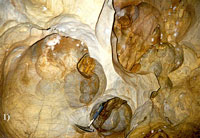 |
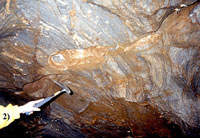 |
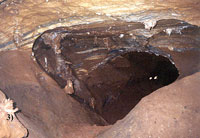 |
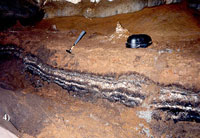 |
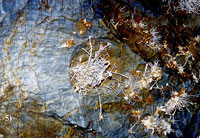 |
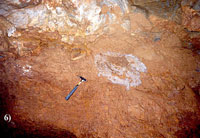 |
fig. 2. Photographs of typical forms and speleothems in the cave. 1 – cupola-shaped depressions in the roof of Hviezdna Hall; 2 – aragonite of the oldest generation truncated by bevels in Hlboký Hall; 3 – cross-section of the passage between Ježovitá and Aragonitová Passages, showing planes of repose; 4 – the sedimentary profile in Oválna Passage; 5 – aragonite of the second generation in Oválna Passage; 6 – the youngest aragonite on ochres in Ježovitá Passage (photos 1 to 4 and 6 by P. Bella, photo 5 by A. Lucinkiewicz).
Mineralogy
Methodology
Twenty three samples of ochres, clays, broken aragonite speleothems and neomorphic aragonite were collected in the cave. Twelve typical samples were studied by SEM and analysed on 60 points by EDAX (LINK connected to a JEOL-JXA-50A Microprobe). A total of 34 X-ray diffraction analyses were made (Philips Diffractometer PW 3710). Powder produced for the X-ray work was also analysed by microprobe. Mn oxides were separated by sieving, and in a settling column using deposition times ranging from 2 hours to 8 days. Individual portions were structurally analysed. Mn oxides, goethite and allophane were analysed by DTA and TG (TG-750 Stanton-Reford, University of Chemical Technology, Prague). Carbon and oxygen stable isotope ratios were measured with a Finnigan MAT 251 Mass Spectrometer (Czech Geological Institute, Prague). Water content in ochres was calculated from weight loss at 70 oC. All analyses, except where otherwise mentioned, were carried out at the Institute of Geology, AS CR Prague. Other speleothems were visually examined in the cave with a portable UV-lamp (253 and 360 nm).
Goethite
The ochres are soft and moist, containing 47 to 56 % of water by weight. They formed from weathered ankeritic and sideritic metasomatites and also cover cave walls as irregular crusts deposited from waters. Goethite is present as an extremely fine-grained to cryptocrystalline, although not amorphous, matrix in the ochres and as fine acicular forms (several mm) „floating“ in fine-grained ochre. The moisture content of the ochres distinctly influences the humidity of the air analysed in the cave, as the ochres function as a humidity exchanger, able to adsorb and release water vapour.
The ochres contain irregular laminae of birnessite, a Mn oxide. In addition to inclusions liberated by weathering (quartz), the ochres contain clay minerals (muscovite 2M1, illite, probable chlorite and 14.8 Å smectite) that were deposited on the rock surface in flooded cave conditions. Some of the ochres contain greater concentrations of P2O5 (0.3 to 1.0 %; Table 1).
Asbolane
Black Mn ochres occur as an admixture in the Fe ochres and other cave fills. They are derived from the ankeritic metasomatites, which contain about 2 % MnO. The sequence in Oválna Passage (fig. 2/4) is composed of very fine-grained massive brown clay (a mixture of goethite and clay minerals) and includes a layer about 300 mm thick that is composed of several bands of Mn ochres with abundant intercalations of white allophane and redeposited Fe ochres. Asbolane is abundant here as soft, black, earthy material with a clayey appearance. Complete samples and various grain-size fractions were analysed. There were problems of exact identification due to structural disordering, the almost amorphous nature of the mineral, and from coalescing diffraction lines. Submicron-sized plates of muscovite 2M1 remained in the sample even after extended sedimentation, masking other diffuse diffraction lines.
Asbolane comprise about 30 to 40 % of the black fills. It is usually accompanied by muscovite, and also by quartz, goethite, allophane, birnessite, apatite, anatase and, more rarely, by rutile and authigenic La-Nd-bearing phosphate. Nickel contents can reach 1.9 to 3.9 % (Table 1), while the magnesium content is relatively stable but can be locally enriched (2.4 to nearly 10 %). Similar variability was detected in P, Ba (0.4 to 1.4 %) and the rare earth elements (REE).
Sometimes the asbolane consists of microscopic globules of Mn-oxide covered by fine fossilised organic filaments, indicating the microbial conversion of Mn2+ to Mn4+. The asbolane layers probably result from bacterial precipitation in shallow residual pools as the cave is in the late, very slow, stages of draining episodic flood waters (see also Andrejchuk and Klimchouk, 2001).
fig. 3. X-ray diffraction of the asbolan layer. A – asbolan, Q – quartz, M – muscovite, G – goethite.
Table 1
Representative chemical analyses of selected minerals
Sample/Oxide |
ochre |
asbolane |
allophane |
muscovite |
La-Nd-bearing phosphate |
|
SiO2 |
4.31 |
23.88 |
51.14 |
57.67 |
14.09 |
|
TiO2 |
0.05 |
nd |
0.19 |
0.40 |
nd |
|
Al2O3 |
2.48 |
24.24 |
41.16 |
33.45 |
13.71 |
|
Fe2O3/FeO* |
84.01 |
*2.14 |
1.29 |
0.75 |
*5.94 |
|
Na2O |
0.16 |
1.03 |
0.08 |
0.11 |
1.04 |
|
K2O |
0.27 |
0.10 |
0.20 |
11.86 |
0.20 |
|
CaO |
0.57 |
1.22 |
3.29 |
0.08 |
4.01 |
|
MgO |
1.80 |
13.28 |
2.27 |
1.91 |
2.37 |
|
MnO |
6.34 |
29.65 |
0.37 |
0.23 |
27.8 |
|
BaO |
nd |
nd |
nd |
nd |
1.40 |
|
NiO |
3.94 |
3.94 |
nd |
nd |
2.87 |
|
P2O5 |
0.52 |
0.52 |
nd |
nd |
5.46 |
|
La2O3 |
nd |
nd |
nd |
nd |
12.21 |
|
Nd2O5 |
nd |
nd |
nd |
nd |
8.91 |
nd - not determined
Birnessite
Birnessite occurs as a soft black substance. It cannot be distinguished optically from the asbolane. Birnessite was identified both in Fe ochres (as fine darker coloured and irregular bands) and in the asbolane layers where it is probably a product of maturation of asbolane.
Allophane
Allophane was found only in the asbolane deposits, as separate white, fine-grained earthy layers 30 to 80 mm thick disintegrating into cubes, or as admixtures within the asbolane. Allophane was identified by chemical analyses, X-ray diffraction and particularly by DTA and TG analyses (fig.4).
fig. 4. DTA/GTA curves of asbolane (a) and allophone (b) from the Oválna Passage (velocity of heat 10 oC min-1, air 10 ml.min-1, sensitivity DTA 10μV(10 mV).
Allophane is an uncommon mineral in karst caves (Hill and Forti, 1997, p. 179-181), but nevertheless, is relatively abundant in speleothems growing in abandoned mines. It has also been found in pseudokarst fissure caves (Cílek, Langrová and Melka, 1998). Allophane commonly forms in the acidic environment produced by weathering of sulphides in the surrounding rocks. Its occurrence in limestone environments that are usually associated with high pH may therefore appear somewhat surprising. However, its presence is a strong indication that sulphide weathering played a role during speleogenesis of the cave.
Halloysite
A mineral of the kaolinite group, structurally similar to halloysite, occurs as an indistinct admixture in the allophane. It was detected by X-ray diffraction. We presume that it formed either by maturation of the allophane or that the allophane was formed by the transformation of weathering products containing minerals of the kaolinite group.
Anatase
Authigenic cryptocrystalline anatase forms amoeba-like patches of cement in small fragments of brown ferruginous clayey siltstones/sandstones. The fragments represent relics of kaolinitisation products washed down into the cave. Anatase was detected by chemical analyses and on the basis of morphological comparison with samples from the Czech Karst (Cílek, 1989; Cílek and Bednářová, 1993).
Apatite
Authigenic apatite forms irregular thin laminae, less than 1 mm thick, and irregular amoeba-like impregnations in the asbolane profiles. It was detected by chemical analysis and X-ray diffraction. Migration of Ca-phosphate requires an acidic environment. Phosphates, other than those derived from guano, precipitate in limestone from relatively acidic surficial P-enriched solutions, which have been leached from soil and weathering profiles.
Accessory minerals
Muscovite 2M1 is a very common accessory mineral, detected in samples by X-ray diffraction, then separated and chemically analysed. The typical chemical analysis is given in Table 1. Muscovite occurs as very fine-grained plates. It is probably derived from phyllites. Quartz occurs as angular and corroded silt-sized grains. Its character indicates that it was derived from dissolution of limestones and comes from the immediate surroundings rather than being transported over a long distance. Acicular rutile was found in some places associated with anatase cement.
La-Nd-bearing phosphate
Detailed sampling of the asbolane layer revealed places with increased P content in the form of apatite (X-ray identification). In other places the P content was slightly greater than Ca content. Nevertheless, high La (La2O3 up to 12.21 %) and Nd contents (Nd2O5 up to 8.91 %) occurred in similar positions repeatedly. The La-Nd-bearing phases are very fine-grained (tens of mm) and cannot be macroscopically distinguished within the black asbolane. The chemical composition of the phosphate-asbolane layer with high REE and Ba contents is listed in Table 1.
The REE regularly occur in association with high P concentrations. In some places the REE concentration is higher than the P contents, so the relationship between REE and Mn oxides has to be taken into account. A number of REE released by weathering (presumably of volcanics) can migrate efficiently within carbonate sequences. They form authigenic minerals only with difficulty, but they can be fixed in finely dispersed phosphate or in Mn oxides. Due to local permeability and diversified sources, apatite has formed only in some parts of the karst fills. In other places the possible effect of phosphate molecular sieving led to formation of REE-bearing phosphates. The excess of the REE concentration became bound to Mn oxide.
Aragonite
Aragonite speleothems are the outstanding feature of this cave. According to Rajman et al. (1990, 1993), aragonite speleothems have been traditionally classified according to their morphology into: kidney-shaped, acicular and spiral (i.e. flos ferri) forms. Cílek et al. (1998) identified three generations of aragonite speleothems according to their age and/or relationship to the speleogens.
The oldest aragonite generation occurs as massive, whitish milky-coloured, kidney-shaped forms and irregularly corroded relics with polyhedral appearance, rarely more than 300 mm thick (fig. 2/2). The aragonite is highly and irregularly recrystallised and corroded. Fine-grained parts are still composed of aragonite (radial-fibrous aggregates), with some calcite (blocky mosaic). Recrystallised patches consist of calcite, with some aragonite, mica and quartz (X-ray analysis). Fine box-work structures or very fine dogtooth-like crystals cover walls of corrosion voids. Some voids are filled with younger milky-white finely radial-fibrous aggregates of aragonite or by mica-rich sediment (X-ray detection). Long duration phosphorescence (up to 5 s.) after illumination by UV-lamp differentiates the oldest generation from the younger one. Plane solution roofs (bevels) commonly truncate the oldest aragonite.
The second generation of aragonite occurs as long needles and helictites, so-called acicular and spiral forms, up to several hundred millimetres long (fig. 2/5). It displays fluorescence, but no phosphorescence in UV-light. The aragonite needles are sometimes associated with globular opal. Crystal faces do not display any corrosion, even under high magnification (x30 to 500). Microscope and field observations indicate that this generation of aragonite has been growing continuously up to the present time, explaining its bright white colour and fresh appearance.
The youngest aragonite generation has not previously been detected due to its tiny size (fig. 2/6). It occurs as fine fan-like forms with diameter of 2 to 4 mm (sometimes more) and as miniature helictites with lengths not exceeding 40 mm. The helictites usually grow from centres of radial aggregates. These forms – “frostwork” – grow on soil and Fe ochres, typically above the lake in Hlboký Hall. Here, aggregates cover thin coatings of loam and ochre deposited from stagnant water. There was inhomogeneous glowing, with greenish and bluish points and phosphorescence of 1 to 2 seconds duration appeared when the aragonite was illuminated by the UV-lamp.
Aragonite genesis
Two principal factors caused deposition of aragonite in Ochtiná Aragonite Cave: (1) high concentrations of Mg, Fe and Mn ions in the karst solutions, and (2) a closed and deeply-seated, partly flooded cave environment with a high proportion of the walls covered by moist Fe ochres.
The ochres act as a humidity exchanger between the walls and the cave atmosphere. Ochtiná aragonite occurs most frequently on substrates with water rising by capillary action or with very slowly percolating water on moist sediments, which slowly release water vapour into the cave atmosphere. A similar situation is also observed in Zbrašovské Aragonite Caves (Czech Republic).
The isotopic ratio of carbon in the aragonite, d13C, varies between -7.4 and -6.0 ‰ (PDB). Oxygen isotopic ratio (d18O) was found to range between -7.0 and -6.3 ‰ (PDB). The C and O isotopes thus are within the range typical for the slow, equilibrium release of CO2 from solution. The graph in fig. 5 compares aragonites from Ochtiná Aragonite Cave with calcites and aragonites from Starý hrad Cave (Nízke Tatry Mts., Slovakia). Ochtiná aragonites plot within the field of the lowest values of the calcite spelothems from Starý hrad Cave, but distinctly away from the Starý hrad aragonites, indicating different depositional conditions. While aragonite from the well-ventilated Starý hrad Cave shows isotopic equilibrium with common atmospheric carbon dioxide, the Ochtiná aragonite, from a closed environment, shows an anomalous isotopic composition probably caused by a different cave CO2 composition.
fig. 5. The isotopic composition of calcite and aragonites from the well ventilated Starý hrad Cave in the Nízke Tatry Mts. compared with the closed deeper system of Ochtiná Aragonite Cave. Very slow evaporation and isotopic equilibrium fractionation is proposed for the samples from Ochtiná (AII and AIII – aragonite generations).
Rapid kinematic processes and evaporation can be excluded from any role in the deposition of the aragonite with a high degree of certainty. The genesis of the aragonite in Ochtiná Aragonite Cave cannot be completely explained until data from direct measurement of CO2 concentrations and isotopic composition in the cave air are available. Nevertheless, the isotopic data show one important result - the neomorphic aragonite of the youngest generation has an identical isotopic composition that is nearly identical to as the acicular aragonite of the second generation - both types thus were deposite under the same conditions, which are very similar to the modern ones.
U series ages of the aragonite deposits
Samples of aragonite and calcite have been dated in two laboratories – at McMaster University, Hamilton, Canada (Ford) and at the Institute of Geological Sciences, Polish Academy of Sciences, Warsaw, Poland (Hercman). Two applications of the 230Th/234U method (Ivanovich and Harmon, 1992) were adopted, the first using the older standard means of estimating the ratio of the two isotopes by counting radioactive disintegrations (alpha particles) by scintillometry; the second using the modern method of direct isotope counting in a mass spectrometer (TIMS – thermal ionisation mass spectrometry; Li et al., 1989).
Mr. Štefan Roda sen. collected samples of the aragonites in Oválna Passage and Hlboký Hall at 1989 or 1990 (locations on the map in Rajman et al., 1990). Ford dated two of them in 1990 (90/Och1 and 90/Och2). All samples had a high uranium content (as is typical in aragonite) and negligible amounts of detrital thorium, and thus yielded precise and unambiguous ages. Results were partly published by Rajman et al. (1993).
Sample 90/Och2 was a portion of aragonite flowstone broken during trail construction. It was 20 mm in thickness, clean and opaque white, with a coconut meat texture. For alpha dating it was cut into three slices of ~7 mm thickness each (samples Och2A, Och2B and Och2C), representing the top, middle and base of the deposit respectively. All three analyses yielded U contents of 8-10 ppm. Thorium was lost from Och2C during the extraction, with the result that no date could be obtained. Sample Och2B from the middle third of the flowstone gave an age of 138,000±7,000 years BP, where ±7,000 is the one standard deviation statistical counting error. Sample Och2A from the top one third of the flowstone gave an age of 121,000±6,500 years.
If sample Och2 grew at a constant rate between Och2B and Och2A, then the accumulation rate was ~0.41 mm/1,000 years. If it is further assumed that all of the deposit grew at this constant rate, then its growth commenced about 162,000 years ago and ceased at approximately 115,000 years.
Sample 90/Och1 consisted of three broken aragonite spiral helictites (“needles” or “whiskers”), all measuring about 60 mm in length and tapering from ~3 mm external diameter at the base to ~2 mm at the tip. They contained central canals for water flow but the tips were sealed. The needles appear to be extending by fluid permeating out and precipitating in the region of the tips and it was supposed that the latter were modern. The observed sealing of the tips might possibly be a consequence of the artificial opening of the cave changing the microclimate.
The basal 15 mm of one needle were analysed by the alpha method in 1990 (sample 90/Och1), yielding the remarkable U content of 15 ppm and an age of 13,600±500 years (one standard deviation). As a check, a second needle was analysed by mass spectrometry in 1995. The basal 15 mm of growth contained 16 ppm U and yielded an age of 13,300±68 years (two standard deviation error). No age could be derived for the top 15 mm (18 ppm U) because it had insufficient thorium; this implies that it is both very clean (no detrital contamination problems) and young, supporting the assumption that the very tip is modern. From these measurements we establish that the needle grew ~52.5 mm in 13,300 years, giving a mean extension rate of about 4 mm per 1,000 years.
Two pieces of the oldest aragonite generation truncated by bevels from the junction of the Oválna Passage and Hlboký Hall (samples JOA 1 and JOA 2) were corroded and partially recrystallised to calcite. Measurements were done with alpha spectrometry (OCTET PC, EG&G ORTEC; by Hercman in 1999). Both analyses yielded low uranium contents (0.6 and 3 ppm) and a 230Th/234U ratio significantly higher than 1 (about 1.4). The high ratio, unusual in the nature, suggests that there was preferential leaching of uranium from the samples during recrystallisation and/or corrosion, rendering computed age unreliable. Therefore, TIMS U series analyses were made by Ford in 2001 on similar eroded old aragonite and calcite flowstone of the oldest generation that were found as fragments within the cave. The mineralogy was confirmed by X-ray diffraction. The extractions were carried out in a clean room with laminar flow hoods, and two analyses were made of each sample. Results are summarised in Table 2.
Table 2
TIMS U series analyses
Sample No. |
U content [ppm] |
234U/238Th |
230Th/234U |
230Th/232Th |
Age [y] |
|
01 Och 1A |
5.5 |
0.9934 |
1.046±0.003 |
63,000 |
Age cannot be calculated |
|
01 Och 1 B |
5.6 |
0.9975 |
1.057±0.003 |
49,000 |
Age cannot be calculated |
|
01 Och 2 A |
0.76 |
1.0268 |
0.9938 |
7,065 |
449,000 +69,000 |
|
01 Och 2 B |
0.67 |
0.9999 |
1.0101±0.007 |
7,064 |
Age cannot be calculated |
N.B. Error margins quoted are two standard deviations
Two analyses of aragonite show that the sample is very clean and has the high U content typical of aragonite. The 230Th/234U ratio is just in secular equilibrium, so that an age cannot be obtained by this method. 234U/238U on the other hand is not in equilibrium, implying that the sample is certainly younger than 1,250,000 years. It is probably a little older than the calcite sample.
Two analyses of calcite are very similar. The U content is satisfactory for calcite (most speleothems have between 0.05 and 1.0 ppm). The sample is clean (230Th/232Th >>20). In the second analysis the 230Th/234U ratio just exceeded 1.0000, possibly from detritus. But it is very similar to the first analysis in all other respects. This can be taken as confirmation that the age estimate of approximately 450 ka is acceptable.
Palaeomagnetism
A clastic sediment section well exposed on the northern side of the Oválna Passage is about 0.7 m high (fig. 1). From the top, it is composed of the following layers: 1 – white flowstone with stalagmite; 2 – clay, reddish brown, with greyish black schlieren enriched in Mn-compounds, massive, laminated in places, disintegrated into irregular polyhedral fragments (samples OCH 1 and OCH 2); 3 – alternation of reddish brown clay (thickness max. 1.5 cm; samples OCH 3 and OCH 4) with layers blackened by Mn-rich minerals (thickness from 4 to 6 cm), and white bands with allophane crystals (thickness of 1 to 5 cm; fig. 2/4); 4 - clay, reddish brown, massive, disintegrates into irregular polyhedral fragments (sample OCH 5).
The flowstone, about 1-2 cm thick (layer No. 1 on fig.1) was dated by the U series alpha counting method (Hercman). The U content (about 6 ppm) was similar to aragonite samples (see above). The content of detrital Th was negligible. The analysis gave an age of 164,000±7,500 at one standard deviation.
Methods
Samples were demagnetised by the alternating field procedures up to 1,000 Oe with a Schonstedt GSD-1 machine. The remanent magnetisation Jn was measured on a JR-5 spinner magnetometer (Jelínek, 1966). Values of volume magnetic susceptibility kn were measured on a kappa-bridge KLY-2 (Jelínek, 1973). Separation of the respective remanent magnetisation components was carried out by multi-component analysis (Kirschvink, 1980).
Results
The magnetic properties, both Jn and kn values, of samples from layer No. 2 are distinctly different from those of layers Nos. 3 to 5 (Table 2). Sample OCH 1 (layer No. 2) displays normal remanent magnetisation. All underlying samples are magnetically reversed (fig. 1). This polarity change can be correlated with the Brunhes/Matuyama reversal of 780 ka B.P. (Pruner et al. 2000), because the speleothem date of 164 ka establishes that it must be older than any of the short-lived reverse magnetic excursions within Matuyama chron (cf. Zhu and Tschu, Eds. 2001).
Table 3
Principal magnetic properties of samples
Sample No. |
Jn [pT] |
Kn [10-6SI] |
Polarity |
|
OCH 1 |
30,375 |
714 |
Normal |
|
OCH 2 |
35,651 |
1,999 |
Reverse |
|
OCH 3 |
11,879 |
347 |
Reverse |
|
OCH 4 |
283 |
176 |
Reverse |
|
OCH 5 |
1,715 |
161 |
Reverse |
|
Mean value |
15,981 |
679 |
|
|
Standard deviation |
16,285 |
771 |
Discussion
At several places in the cave it can be clearly seen that the voids were filled by ochres which were later removed. Floors of passages that are partly filled at present have an oval shape. They were formed either before the ochres were produced by ankerite oxidation or before the eroded ochre residuum was deposited in water-filled passages.
The first subsurface cavities were formed by corrosion of the limestone and oxidation of the ankerite. These cavities were flooded by meteoric water infiltrating along the major fault line in Vstupná and Mramorová Halls and also along the lesser fissures in Hlboký Hall and Sieň mliečnej cesty Hall. Continuous and dominantly horizontal cavities formed along parallel fissures. Irregular corrosion features developed on the bedrock surfaces, these were considerably enlarged and modified by later corrosional events. The only original forms still preserved are irregular niches and cupolas found above the younger corrosion bevels. The source of the carbon dioxide for intensive corrosion can be found in the ankerite weathering with an end product of goethite, i.e. by a process similar to that described by Kempe (1998) from Harz (Germany), according to following equations:
2FeCO3 + 2CO2 + 2H2O = 2Fe(HCO3)2 [1]
then
2Fe(HCO3)2 + 1/2O2 + H2O = 2Fe(OH)3 + 4CO2 [2]
or
4FeCO3 + O2 + H2O = 2Fe2O3.nH2O + 4CO2 [3]
where 2Fe2O3.nH2O is limonite.
The frequent presence of pyrite inclusions in the limestones and of allophane, a typical product of acid decomposition of clay minerals, suggests that the corrosion might have been enhanced sulphide weathering and oxidation to H2SO4. However, the absence of any gypsum replacing limestone or of native sulphur in the cave indicates this effect was probably minor.
The origin of the niches and cupolas was linked by some authors (Nicod, 1974; Choppy, 1994) with hydrothermal processes. However, both forms can originate from convection induced by gravitational settling of water enriched with solute ions, without any hydrothermal influence (cf. Curl, 1966; Cordingley, 1991; Klimchouk, 1997a). The density of water in the phreatic zone of a karst system will increase as it dissolves the enclosing rock. During continuous or periodic infiltration of “fresh” water into a water-saturated environment, a density gradient forms. This can generate convection cells in the water body, which may produce corrosion forms in the enclosing limestone. The effect is essentially limited to conditions of static or very slow water movement. In rapidly moving water this effect will be negligible.
Convection is a differential process, the dissolution producing roof cupola- and tube-like depressions in roofs that are below the waterline, horizontal ceilings (bevels) or corrosion notches in the walls at the waterline, and inclined planar walls beneath it. Convection circulation and solution cannot only modify morphological forms but it can also influence the entire pattern of such cave systems during their initial phases where the waters are predominantly static or semi-static. This feature is particularly common where there is artesian speleogenesis (Klimchouk, 1997b).
Ochtiná Aragonite Cave is developed in an isolated lens of limestone surrounded by insoluble rocks. Such lenses readily fill with water during floods and drain only slowly afterwards. Corrosion notches along the walls are produced in very acidic stagnant water conditions and where roofs dip down they will eventually be planed off as bevels at the waterline. Stagnant water still forms a lake in the deepest part of Hlboký Hall. The difference of elevation between the highest bevel in the cave and the present lake level is 12 m. Nearly horizontal bedding favoured bevelling in Ježovitá Passage and Aragonitová záhrada, while corrosional ledges that have developed in steeply dipping beds indicate the corrosional origin of the bevels. Notches and bevels commonly intersect the older speleothems, such as those discussed above.
Planes of repose (Lange, 1963; Goodman, 1964) are found in many parts of the cave (fig. 2/3). These are the inclined bedrock surfaces developed in the lower portions of cavern walls. They too formed during periods of very slow water circulation when accumulated insolubles blocked solution enlargement at the base of a wall in a flooded section of cave. In passages where bevels are developed, planes of repose are similar to Facetten (sensu Kempe et al. (1975).
Iron ochres were formed by the weathering of ankerite/siderite metasomatites. The ochres are composed principally of goethite and a variety of autochthonous minerals deposited in flooded cave conditions or by the dripping water. The ochres contain on average 50 % water. They cover a substantial area of the cave and act as an important humidity exchanger stabilising the microclimate.
Black Mn-bearing loams contain Ni-bearing asbolane and birnessite, which developed from asbolane. Mn-oxides were most probably formed by microbial precipitation at the bottom of water bodies, as recently described by Andrejchuk and Klimchouk (2001), i.e. just after the cave was drained and fresh air entered it. Beds of allophane occur within the asbolane layers (fig. 2/4). Because it forms in a low pH environment, allophane is not a common mineral in karst caves. We suggest that the allophane could have formed in the acidic conditions produced by weathering of sulphide minerals. A kaolinitic mineral similar to halloysite was formed by maturation of allophane. The asbolane layer formed an important geochemical barrier, which caused the concentration of the REE, the growth of La-Nd-bearing phosphate and eventually the formation of the REE-enriched Mn oxide.
The allogenic minerals, which have entered the cave are extremely fine-grained and partly weathered and abraded. They indicate that the cave was poorly connected with the surface, allowing only slow infiltration through narrow or choked fissures, rather than direct, open communication with flowing streams.
There are three different generations of aragonite. The oldest speleothems are preserved as corroded relics truncated by bevels (fig. 2/2). The aragonite in them is partly recrystallised to calcite. There were at least two separate periods of the growth. TIMS U series ages for recrystallised calcite of the older sample indicate an age of about 450 ka. TIMS U series ages for the aragonite cannot be calculated as they are at the limit of the method. 234U/238U on the other hand is not in equilibrium, implying that the sample is certainly younger than 1.25 Ma. It is probably a little older than the calcite sample and related to a warm episode of Elster 1/2.
The aragonite in the younger recrystallised speleothems yielded U series dates indicating an Eemian age (138-121 ka). The pre-recrystallisation age may be greater. The second aragonite generation, of spiral and acicular aggregates (fig. 2/5), began to be deposited during Late Glacial (Allerod, 14 ka). Growth has continued to the present day. The youngest generation, of fine acicular aggregates of aragonite and miniature helictites, is also actively growing (fig. 2/6). Both of the younger generations have similar isotopic compositions, indicating that they originated in conditions very similar, or identical, to those found at present in the cave.
Conclusions
The modern morphology of the cave reflects a comparatively complex evolution under particular lithological and hydrogeological conditions within an isolated lens of karst rock surrounded by insoluble rocks. Such lenses can become filled with water, often with artesian confinement. Primary phreatic subsurface cavities were formed by the corrosion of the limestone and oxidation/erosion of the ankerite. Elongated, chiefly horizontal cavities formed along parallel fissures. Irregular corrosion forms developed on the bedrock surfaces. The niches and cupolas are relics of phreatic speleogens created by convection induced by gravitational, density-derived circulation of water in a regime of very slow flow. Hydrothermal effects are not necessary. The abundant pyrite together with a common allophane indicates the carbonic acid corrosion was most probably enhanced by sulphide weathering producing diluted brines. Thermohaline convection cells operating in the flooded cave might also have influenced the wall morphology.
Younger corrosional events under vadose conditions changed the original forms to a large extent. The intensity of corrosion was enhanced by carbon dioxide from ankerite weathering in the oxidising meteoric waters. The water-level fluctuations were repeated several times as indicated by several levels of flat roofs (bevels), wall niches and planes of repose. Bevels form by corrosion in stagnant water conditions. Roof planation was influenced both by limestone bedding and by the duration and intensity of water convection. Bevels intersected older speleothems. Corrosion notches along the walls indicate that the levels of stagnant water were stable for long periods, representing significant phases of cave enlargement. Planes of repose also indicate slow water circulation following floods; accumulated insolubles blocked solution enlargement at the base of a cave wall.
Water-level oscillations and water flow have to be very slow, as indicated by the fact that the sediment section studied in Oválna Passage survived several submergences. Nevertheless, the velocity of flow during the early phases of the cave evolution had to be sufficient to transport the clastic products of the ankerite disintegration into lower levels of the cave.
Dating this sequence of processes is a complicated and risky task. We can assert that the cave started to form before 0.78 Ma according to the palaeomagnetic data from the oldest dated cave fill in Oválna Passage. The roof of that passage is the highest preserved bevel to have developed under the succeeding vadose conditions. We may tentatively link the formation of this highest bevel with the oldest sedimentary fill. Therefore, vadose conditions probably were established 0.78 Ma. The phreatic phase of cave development has to be older (Late Tertiary/Pleistocene), but it cannot be dated properly. It appears that the age of cave origin is close to that suggested by Kubíny (1959) and Homza, Rajman and Roda (1970). The sequence of cave development summarised in Table 4 is based primarily on the U series dating of flowstones and aragonite/calcite speleothems.
Table 4
Succession of processes during the origin of Ochtiná Aragonite Cave
Age (ka) |
Process |
Water regime |
Notes |
|
Upper Cretaceous |
Hydrothermal activity |
Thermal |
|
|
Late Tertiary |
Initial speleogenesis |
Phreatic |
|
|
Cave enlargement |
Epiphreatic, vadose |
Asbolane as a product of sulphide weathering by oxidising waters |
|
|
>780 <780 |
Corrosion, bevels and deposition of sediments (Oválna Passage) |
Highstand Lowstand |
|
|
Glacial? |
Erosion/redepositon of cave fill, possible bevels |
Fluctuations |
Periods of water highstands not excluded, CO2 released from ankerite decomposition in oxidising waters |
|
500 450 |
Speleothems, the oldest generation I |
Lowstand |
Calcite recrystallised from aragonite prevails and is somewhat younger than aragonite (ca 50 ka) |
|
Glacial? |
Corrosion, bevels, cut of rocky pendants, erosion/redeposition of cave fill |
Highstand and fluctuations |
CO2 released from ankerite decomposition in oxidising waters |
Acknowledgements
The authors wish to express their thanks especially to Dipl.-Ing. Jozef Hlaváč, Director of the Slovak Caves Administration in Liptovský Mikuláš and Mr. Ján Ujházy, Head of the Ochtiná Aragonite Cave for permission to conduct research and to take samples during a period of 1996 to 2001. We acknowledge the contribution of: Dr. Karel Melka and Mr. Jiří Dobrovolný (X-ray analyses and interpretations), Dipl-Ing. Anna Langrová (microprobe analyses; all from Laboratory of Physical Methods, Institute of Geology, AS CR Prague), Dr. Daniela Venhodová (production and evaluation of palaeomagnetic data; Department of Palaeomagnetism, Insitute of Geology AS CR Prague), Dr. Karel Žák (isotopic analyses; Czech Geological Institute, Branch Barrandov, Prague), and Dr. Jana Ederová (DTA-GTA analyses, University of Chemical Technology, Prague). The research was carried out under the Agreement on Scientific Co-operation between the Slovak Caves Administration and the Institute of Geology AS CR. Costs were covered from sources of the Caves Administration (Task B. of the Main Activity Plan in 1998), Plan of Scientific Activity No. Z 03-013-912 of the Institute of Geology AS CR, and Grant No. A3013201 of the Grant Agency of AS CS. U series analyses by Ford at McMaster University were supported by a grant in aid of research from the National Scientific and Engineering Research Council of Canada.
References
- Andrejchuk V.N. and Klimchouk A.B. 2001. Geomicrobiology and Redox Geochemistry of the Karstified Miocene Gypsum Aquifer, Western Ukraine: The Study from Zolushka Cave. Geomicrobiology Journal 18: 275-295.
- Andrusov D. 1958. The geology of Czechoslovak Carpathians, Part I. Publ. House Slovak Acad. Sci., 304 pp. Bratislava (in Slovak).
- Bajaník Š. and Vozárová A. (Eds.). 1983. Explanations to the geological map of the Slovenské rudohorie Mts. – eastern part (in Slovak). Geol. Inst. D. Štúr, 223 pp. Bratislava (in Slovak).
- Bella P. 1995. Principles and theoreticaly-metodical aspects of classification of cave morphological types. Slovenský kras 33: 3-15. Liptovský Mikuláš (in Slovak, Engl. summ).
- Bella P. 1997. The views to the genesis of the Ochtiná Aragonite Cave (in Slovak). Aragonit 2: 13-14. Liptovský Mikuláš (in Slovak).
- Bella P. 1998. Morphological and genetic features of the Ochtiná Aragonite Cave. Aragonit 3: 3-7. Liptovský Mikuláš (in Slovak, Engl. summ).
- Choppy J. 1994. La première karstification. Synthèse spéléologique et karstique. Les facteurs géographiques 3. Spéléo-Club de Paris, Club Alpin Français, 1-70. Paris.
- Cílek V. and Bednářová J. 1993. Silcretes in the Bohemian Karst. Český kras (Beroun) 18: 4-13 (in Czech, Engl. summ.).
- Cílek V., Bosák P., Melka K., Žák K., Langrová A. and Osborne A. 1998. Mineralogical investigations in the Ochtiná Aragonite Cave. Aragonit 3: 7-12. Liptovský Mikuláš (in Czech, Engl. summ.).
- Cílek V., Langrová A. and Melka K. 1998. Pseudokarst phosphate-allophane speleothems from ice caves of the Podyjí National Park. Speleo (Praha) 26: 20-27 (in Czech, Engl. summ.).
- Cílek V. and Šmejkal V. 1986. The origin of aragonite in caves. The study of stable isotopes. Československý kras 37: 7-13. Praha (in Czech, Engl. summ.).
- Cordingley N. J. 1991. Water stratification in active phreatic passages. Cave Science 18(3): 159. London.
- Curl R. L. 1966. Cave conduit enlargement by natural convention. Cave Notes 8, 1: 4-8. Castro Valley.
- Droppa A. 1957. Ochtiná Aragonite Cave. Geografický časopis 9, 3: 169-184. Bratislava (in Slovak, Russ. and Germ. summ.).
- Ford D. C. and Williams P. W. 1989. Karst Geomorphology and Hydrology. Unwin Hyman, 601 pp. London-Boston-Sydney-Wellington.
- Gaál Ľ. 1996. Exploration and protection of aragonite caves in surroundings of the Hrádok Hill. In Sprístupnené jaskyne – výskum, ochrana a využívanie jaskýň, zborník referátov, P. Bella (Ed.): 130-133. Liptovský Mikuláš (in Slovak, Engl. summ.).
- Gaál Ľ. 1998. Karst phenomena in the surroundings of the Hrádok Hill and their relation to the Ochtiná Aragonite Cave. In Výskum, využívanie a ochrana jaskýň, zborník referátov, P. Bella (Ed.): 44-52. Liptovský Mikuláš (in Slovak, Engl. summ.).
- Gaál Ľ. and Ženiš P. 1986. Karst of the Revúcka Highland. Slovenský kras 24: 27-60. Liptovský Mikuláš (in Slovak, Russ. summ.).
- Goodman L. R. 1964. Planes of repose in Höllern, Germany. Cave Notes 6, 3: 17-19. Castro Valley.
- Ivanička J., Snopko L, Smopková P. and Vozárová A. 1989. Gelnica Group – Lower Unit of Spiško-gemerské rudohorie Mts. (Early Paleozoic, West Carpathians). Geol. Zbor. Geol. Carpath. 40, 4: 483-501. Bratislava.
- Hill C. and Forti P. 1997. Cave Minerals of the World. Second edition. Natl. Speleol. Soc., 463 pp. Huntsville.
- Homza Š., Rajman L. and Roda Š. 1970. Origin and evolution of karst phenomenon of the Ochtiná Aragonite Cave. Slovenský kras 8: 21-68. Liptovský Mikuláš (in Slovak, Engl. abs., Germ. summ.).
- Ivanovich M. and Harmon R.S. 1992. Uranium Series Disequilibrium. Applications to Environmental Problems. 2nd Ed. Clarendon, 910 pp. Oxford
- Jelínek V. 1966. A high sensitivity spinner magnetometer. Studia geophysica et geodetica 10: 58-78. Praha.
- Jelínek V. 1973. Precision A.C. bridge set for measuring magnetic susceptibility and its anisotropy. Studia geophysica et geodetica 17: 36-48. Praha.
- Jennings J.N. 1985. Karst Geomorphology. Oxford, Basil Blackwell, 293 pp.
- Kempe S. 1998. Siderite weathering, a rare source of CO2 for cave genesis: the Eisenstein Stollen System and adjacent caves in the Iberg, Harz Mountains, Germany (abs.). Journal Cave Karst Studies 60, 3: 188. Huntsville.
- Kempe S., Brandt A., Seeger M. and Vladi F. 1975. „Facetten“ and „Laugdecken“, the typical morphological elements of caves developed in standing water. Annales de Spéleologie 30, 4: 705-708. Moulis.
- Kirschvink J. L. 1980. The least-squares line and plane and the analysis of palaeomagnetic data. Geophysical Journal of the Royal Astronomical Society 62: 699-718. Oxford.
- Klimchouk A. 1997a. Artesian speleogenetic setting. Proc. 12th Int. Congr. Speleology 1: 157-160. La Chaux-de-Fonds.
- Klimchouk A. 1997b. Speleogenetic effects of water density differences. Proc. 12th Int. Congr. Speleology 1: 161-164. La Chaux-de-Fonds.
- Kubíny D. 1959: Aragonite cave in Slovakia. Ochrana prírody 14, 1: 17-18. Bratislava (in Slovak).
- Lange A. 1962. Water level planes in caves. Cave Notes 4, 2: 12-16. Castro Valley.
- Lange A. 1963. Planes of repose in caves. Cave Notes 5, 6: 41-48. Castro Valley
- Li W.-X., Lundberg J., Dickin A.P., Ford D.C., Schwarcz H.P., McNutt R. and Williams D. 1989. High-precision mass-spectrometric uranium-series dating of cave deposits and implications for paleoclimatic studies. Nature 339: 534-536.
- Mišík M. 1953. Geology of the area between Jelšava and Štítnik. Geologický sborník Slov. Akad. Vied 4, 3-4: 557-587. Bratislava (in Slovak).
- Nicod J. 1974. Les régions karstiques de Slovaquie et de Hongrie septentrionale. Bull. Soc. Géogr., N.S. 82, 12, 14: 11-25. Marseille.
- Pruner P., Bosák P., Kadlec J., Venhodová, D. and Bella, P. 2000. Paleomagnetic research of sedimentary fill of selected Slovak caves. In Výskum využívanie a ochrana jaskýň, zborník referátov z 2. vedeckej konferencie, P. Bella (Ed.): 13-25. Liptovský Mikuláš (in Czech, Engl. Summ.).
- Rajman L., Roda Š. jr., Roda Š. sen. and Ščuka J. 1990. Physico-chemical investigation of the karst phenomenon of the Ochtiná Aragonite Cave. Final Report. MS, Slov. Muz. Ochr. Prír. a Jaskiniarstva archive: 1-46. Liptovský Mikuláš (in Slovak)
- Rajman L., Roda Š. jr., Roda Š. sen. and Ščuka J. 1993. Untersuchungen über die Genese der Aragonithöhle von Ochtiná (Slowakei). Die Höhle 44, 1: 1-8. Wien.
- Slabe T. 1995. Cave Rocky Relief and its Speleogenetical Significance. Zbirka ZRC 10, 128 pp. Ljubljana.
- Ševčík R. and Kantor J. 1956. Aragonite cave in the Hrádok Hill near Jelšava. Geologické práce, Zprávy 7: 161-170. Bratislava (in Slovak).
- Tásler R. (Ed.) 1991. Owen 90-New Zealand. Czech Speleol. Soc., 60 pp. Trutnov.
- Tásler R. and Cílek V. 1999. Decoration of giant domes in the Bohemia Cave, New Zealand: the World biggest aragonite cave? Speleofórum ´99 18: 35-40. Praha (in Czech, Engl. abs.).
- Zhu R.X., Tschu K.K. (Eds.) 2001. Studies in Paleomagnetism and Reversals of Geomagnetic Field in China. Beijing, Sciences Press, 168 pp.
